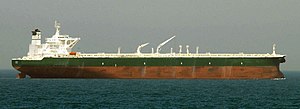Oil
An oil tanker is a type of tanker designed specifically for the transport of crude oil or petroleum products. Currently, all oil tankers under construction are of the double-hull type, to the detriment of the older single-hull (monohull) designs, because they are less sensitive to damage and spillage in collision accidents with other ships or running aground.
From this type of ship, the supertanker arose, with a greater cargo capacity and intended for the transport of crude oil from the Middle East around the Horn of Africa. The supertanker Knock Nevis is the largest ship in the world.
Other than pipeline transportation, tankers are the only means of transporting large amounts of crude, even though some have caused considerable ecological disasters by sinking near shore, spilling their cargo into the sea. The most famous disasters have been those caused by the oil tankers Torrey Canyon, Exxon Valdez, Amoco Cadiz, Erika, Prestige, Aegean Sea, Urquiola, Polycommander,...
Classification
Oil tankers, gas tankers and cargo ships are classified according to their load capacity as:
- Aframax, derived from the Average Freight Rate Assessment, with a capacity of between 80,000 and 125,000 tons.
- Capesizeships with a capacity of between 156,000 and 400,000 tons.
- Chinamax which indicates ships that can lure into Chinese ports, with a capacity of between 380,000 and 400,000 tons.
- Valemax, ships with a capacity of between 380.000 and 400.000 tons operated by the company Vale and mainly dedicated to mineral transport.
- Handymaxships with a capacity of between 40,000 and 50,000 tons.
- Handysizevessels with a capacity of less than 50,000 tons.
- Malaccamaxwhich indicates ships that can travel through the Strait of Malacca with a capacity between 80,000 and 120,000 tons.
- Panamax, which indicates ships that can travel through the Panama Canal, with a capacity of between 50,000 and 79,000 tons.
- Q-Maxwhich indicates ships that can lure in ports of Catar
- Seawaymaxwhich indicates ships that can travel through the Seaway Canal that joins the Atlantic Ocean with the Great Lakes
- Suezmax, which indicates ships that can travel through the Suez Canal, with a capacity of between 125,000 and 200,000 tons.
- VLCC (Very Large Crude Carrier), with a capacity of more than 300,000 tons.
- ULCC (Ultra Large Crude Carrier), with a capacity of more than 500,000 tons.
Contenido relacionado
Compass Rose
Napster
MacOS
